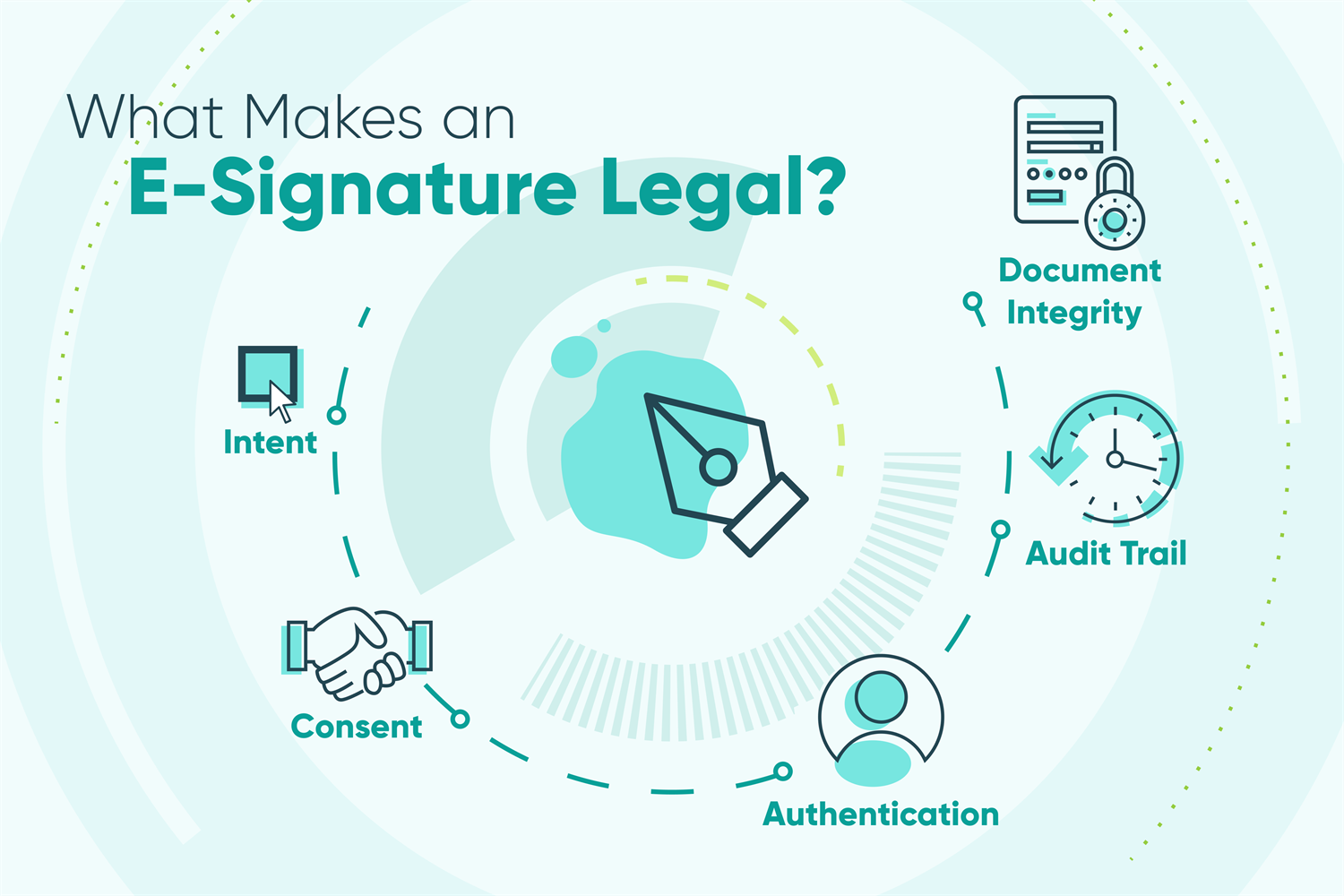Discover the key differences between electronic and digital signatures, learn what makes them legally valid, and find out how to choose the right signing solution for your business.
A signature acts as your seal of approval and is required to show you understand the significance of what you are agreeing to.

A signed document provides a clear record of when and how the agreement was made, which can be crucial in resolving any disputes or misunderstandings. Ultimately, it’s meant to protect both parties.
How you collect legally binding signatures has changed over time. Gone are the days when you only had one legally binding option – a handwritten or “wet” signature.
As the number of companies requiring a signature on seemingly every type of agreement grows, it becomes crucial to use a quick and convenient method to capture signatures.
Luckily, technology and the legal system allow for capturing and embedding electronic signatures on most agreements, contracts, invoices, and other documents.
Before exploring the legal requirements for each type of signature, let’s first clarify the differences between electronic and digital signatures.
What is an Electronic Signature?
An electronic signature (e-signature) is any digital mark on a paperless document indicating acceptance or approval. A digital mark can include typing a name, drawing a signature with your finger or a mouse, or clicking the “I Agree” button to accept terms. E-Signatures are commonly used for business contracts, HR paperwork, and other agreements.
What Makes an E-Signature Legal?

While some laws vary, the five elements outlined in the legislation make an e-signature legal.
-
Intent The signer must clearly demonstrate their intention to sign the document.
-
Consent Both parties must agree to conduct business electronically
-
Authentication There must be a reliable way to confirm the signer’s identity
-
Audit trail The system should record details about when and how the document was signed.
-
Document integrity The e-signature platform should lock or seal the signed version to prevent unauthorized changes.
What is a Digital Signature?
A digital signature is a specialized form of e-signature that encrypts a document to validate an agreement. A trusted service provider (TSP) uses cryptographic methods to add an extra layer of security and provides a digital certificate.
A cryptographic method is any technique used to protect data by scrambling it with codes when it’s being stored or digitally transported. It’s meant to keep that agreement secure and only readable by the intended recipients.
As a part of the cryptographic process, the TSP ensures:
Document authentication
The document is encrypted and authenticated by creating a unique digital fingerprint of the document content.
Identity of the signer
The signer is authenticated through a trusted Certificate Authority (CA) verification, the CA issues the signer a private key that unlocks access for only that individual to sign the document. A public key provides a digital certificate to anyone needing to verify the signer’s identity.
Tamper-proof document
Upon return, the signed document is compared to the original digital fingerprint verifying none of the content was changed. This encryption makes the document tamper-proof and prevents any attempt to alter the document after signing.
Digital signatures are used for high-value transactions, legally sensitive documents, and heavily regulated industries.
What’s the Difference Between Digital Signatures and Electronic Signatures
While both e-signatures and digital signatures allow you to sign documents electronically, their purpose, technology, effort required, and security level differ.
| Feature | Electronic Signature | Digital Signature |
|---|---|---|
| Purpose | General agreements, everyday contracts | High-security documents, often required for legal compliance |
| Cost | Most cost-effective | Higher initial cost |
| How it works | Captures quick consent digitally | Uses cryptographic methods (encryption and certification |
| Authentication | Various methods (two-factor, email, etc) | Certificate authority (CA) |
| Effort | More simple | More complex |
| Security level | Moderate - basic proof of consent | High - due to encryption |
| Global acceptance | Varies - each country has different requirements | Internationally recognized |
How to Determine if a Digital Signature is Needed
Obtaining a digital signature can feel like navigating a labyrinth compared to the straightforward path of capturing an electronic signature. Given the choice, we would almost always choose the easy path.
To determine if the heightened security and verification of a digital signature is required, ask these four questions:
-
Does the document involve high financial risk or liability?
Large monetary sums or contracts with significant repercussions for breach often warrant a digital signature’s enhanced security and traceability. -
Do I need to verify the signer’s identity beyond a reasonable doubt?
All e-signatures verify identity, but digital signatures require cryptographic proof of who signed and provide a digital certificate. -
Will the document be used internationally?
Different countries and regions recognize varying levels of electronic signatures. A digital signature using a globally trusted Certificate Authority is more likely to be accepted. -
Does my company policy require advanced security measures?
Some internal compliance or government rules specify minimum security standards. Companies in finance, healthcare, or government agencies may require the extra security digital signatures provide.
If you answer yes to one or more of these, a digital signature is likely needed.
When Can You Not Use Any E-Signature?
Highly sensitive documents and those governed by strict legal traditions demand the physical signing of a document.
-
Marriage, birth, and death certificates
Vital records require physical certificates, witnesses, and official stamps or seals. -
Wills, codicils, and testamentary trusts
Estate-related documents mandate original ink, witnesses, and sometimes notarization to prevent disputes or fraud. -
Do-not-resuscitate (DNR) orders, powers of attorney, and health care proxies
In healthcare and end-of-life planning, many jurisdictions insist on in-person witnessing and medical personnel to verify competency or notarization. -
Adoption papers, divorce documents, and other family law documents
Family law often requires court oversight, agency authorization, witnesses, or notarization.
What Laws Govern E-Signatures?
As technology provided a way to collect signatures on a computer, questions arose regarding the legality of the agreements. Were they just as legally binding as a “wet” signature? Could they be easily forged or disputed in court? To address these questions, legislators introduced comprehensive e-signature laws.
These laws widely recognize and enforce the legality of electronic signatures, paving the way for modern digital transactions.
-
ESIGN The Electronic Signatures in Global and National Commerce Act (United States, 2000) grants electronic signatures the same legal standing as handwritten signatures in most U.S. states, provided certain disclosure and consent requirements are met.
-
UETA The Uniform Electronic Transactions Act (United States- except New York) sets out guidelines for e-signatures at the state level, ensuring consistency across states.
-
eIDAS The Electronic Identification, Authentication and Trust Services (European Union) regulation defines standards for electronic transactions across the EU, recognizing different levels of e-signatures (from simple to qualified).
-
PIPEDA The Personal Information Protection and Electronic Documents Act (Canada) governs how private sector organizations collect, use, and disclose personal information, including provisions for electronic signatures.
Many other countries have similar legal frameworks or recognize these international standards. These regulations are necessary to establish clear rules that grant electronic signatures the same validity and enforceability as handwritten signatures.
Collect Legal E-Signatures Using Online Forms
Using an online form builder to collect e-signatures can dramatically improve workflow efficiency and legal compliance. Form-building platforms let you create branded forms that capture legally binding signatures.
Cognito Forms is a powerful online form builder that adheres to industry standards, ensuring that the e-signatures you gather are recognized under major e-sign laws. Using Cognito Forms to build your online forms, you can:
-
Build and customize forms quickly: With an intuitive drag-and-drop builder, you can create branded forms and documents tailored to your organization’s needs.
-
Integrate seamlessly: Connect with popular tools like Microsoft Power Automate, Zapier, and more to automate data flow and store signed documents in a secure location.
-
Maintain an audit trail: Comprehensive audit logs record who signed and when, giving you verifiable proof of the signing process.
-
Scale across industries: Whether you work in healthcare, finance, or a small business environment, Cognito Forms accommodates a wide range of compliance and security requirements.
By leveraging Cognito Forms for your e-signature needs, you can speed up your documentation process, reduce overhead costs, and maintain the highest data integrity standards.





